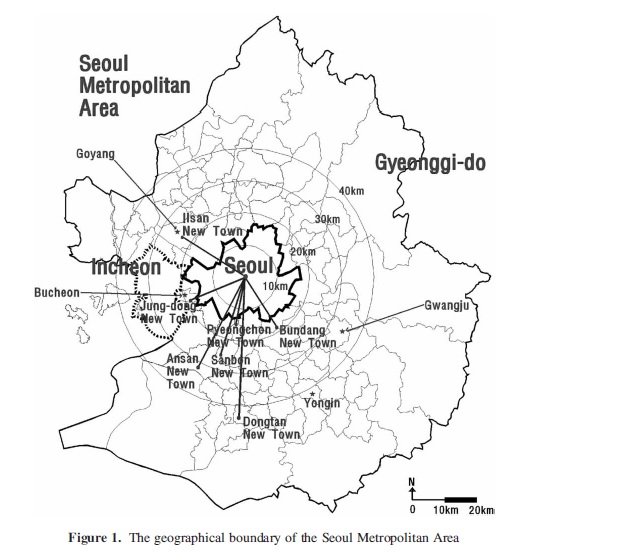“Urban sprawl refers the disorderly and less regulated expansion of housing, and industrial and commercial developments in and beyond the periphery of metropolitan areas.”
In 2000, less than 50% of national population stayed around SMA. The ratio Seoul to SMA was 62.9% (8364379/13298241) in 1985, the ratio became down to 57% (10612577/18586128) in 1990 and 53% (10759454/20397823) in 1995 and 47% (10321449/21827998) in 2000. Seoul population decreased. It was due to the deregulated land development and high demand of housing around SMA. The results of high density of SMA caused negative externalities: traffic congestions and environmental pollution.
Korean government set the zoning system. Its aim was to regulate land development and to maintain balance in development between residential land and agricultural land. As well, in 1971, The Seoul and SME governments which were InCheon City government and KyongGi province organized “two tier systems”. These main administrates played role in ‘upper tier government’, and they were governed by local administrations and established Urban Planning Act (UPA). Under the UPA, local governments simply investigated whether the land developer followed the certain rules for development. According to Cho (2005), he stated that the UPA was essential mechanism for urban growth. The UPA required land owners to strictly stick to the four types of zoning rules: “building height, setback, building coverage, and FAR”. As well 1972, the National Land Use Management Act introduced the National Land Use Planning Area (NLUPA) to control land use outside the UPA.
However there were several reasons how Korean urban sprawl began. In 1993, the Quasi Agricultural Zone (QAZ) was deregulated. It allowed 3 hectares of land to be 500% of the Floor Area Ratio (FAR). The higher % of the FAR referred to the high density of land usage. Usually residential lands had around 500% of the FAR. Thus it showed that 3 hectares allowed land developers to covert agriculture land into residential lands with high rise of apartment. In other words, the deregulation of QAZ increases the speed of conversion on residential land. Thus the ease regulation leads to lack of basic publicity on the land, and ends up urban sprawl.
The 1993 deregulation beyond the coverage of UPA attracted the conversion on land of rural area into residential area. Urban sprawl has been issued in Korea since early 1990s. The total number of conversion of urban and rural edge is over 500 times for 10 years. In KyongGi province especially “areas of YongIn, HwaSeong, and KwangJu, approximately 6% of conversion was found. The conversion of residential land in satellite settlements caused more severe urban sprawl. Cho (2005) claimed that especially the satellite area had lack of public system including sewage system, school, and road. It was quite difficult to support for the expense to the original land owners as taxpayers. They were mainly farmers who do not have strong financial states.
Furthermore, the purpose of the Housing Construction Facilitating Act (HCFA) was providing housing to people who do cannot afford it; however, HCFA under private sector provided housing with small units in less than 3 hectare in order to keep away from strict regulation. As a result, the residential area under HCFA which was under private sectors become scattered land development with lack of infrastructure and poor quality of public facility.
After 1960s, Seoul has been the heart of economic development in Korea. The centralized population around Seoul has changed to decentralized population with broad area of satellite; however it is inevitable that the Seoul Metropolitan Area (SMA) is consequences of urban sprawl. It is because of lack of public system and inefficient land development around the SMA. -Seoul Metropolitan Area (SMA): Seoul, InCheon, and KyongGi province
Korean land development system transformed many times from regulation land development toward deregulation land system. The Korean land system was heavily dependent on private sectors rather than public sector. One reason was to satisfy the current and potential residential living in SMA. Since the demand is skyrocketed, Korean government chose to work with private sector rather than public sector.
For distribution effects of urban sprawl, I do not find paper to example about it. I think the land owner having land that converse from QAZ to QUZ benefits from increase land price. Low income family who cannot afford the housing cannot benefits from increasing housing around SMA. Middle income family who can afford the housing benefits from it.
To make efficient land development, implementing other policy can help reduce the urban sprawl in Korea. Cho (2005) criticized that Korean land system was not effective because development fees collected by local government benefits to land owners. As well he stressed that the fund would reduce the level of urban sprawl when the fees support public project of land development. As well, he stated that the private land developer should supply certain level of infrastructure. Also in order to prevent scattered land development around SMA, it would be necessary that Korean government settle down in the land development instead of relying on private sectors and organized the results from the urban sprawl by implementing appropriate policy.
Cho, Jaeseong. “Urban Planning and Urban Sprawl in Korea” Urban Policy and Research (2006)
Kang, Myunggoo. “Understanding Urban Problems in Korea: Continuity and Change” Development and Society (1998)


